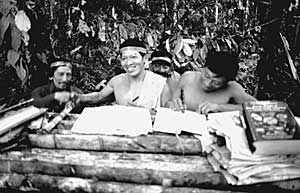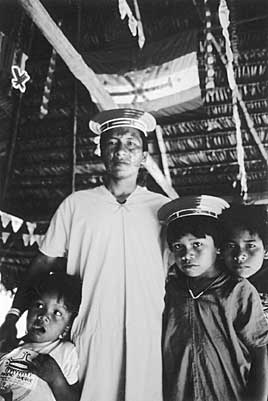ECUADOR
2001 Annual Report
Contents
| Previous | ECUADOR 2001 Annual Report Contents |
Next |
 |
| Plant collecting with Huaorani Forest Masters |
The survival of the practical and well-developed knowledge of the forest realm is crucial for the present and future well-being of rural people who embody this valuable information, as well as for the survival of the forest itself. The importance of protecting the remaining forests and fragile ecosystems becomes clear when we take into account the role of the world's tropical forests in maintaining global climatic stability, harboring incalculable biological and cultural diversity, and in providing fresh water, renewable resources, effective medicine, soil fertility, grounded spirituality, therapy, and shade.
 |
| Secoya teacher and young apprentices |
GO's approach to rainforest protection and cultural renewal can be described as "Conservation Ethnobotany." Over many years of dedicated work we have developed trusting relationships with plant masters, traditional elders, and healers in numerous communities throughout the Upper Amazon. Using ethnobotanical field study techniques to document invaluable botanical wisdom, we then work within these communities to find new ways to assist in the transmission of traditional knowledge of plants and the forest to the next generation. In this way,we strive to keep this knowledge alive in these communities while protecting biodiverse forest ecosystems. Our ethnobotanical work places a particular emphasis on the practical application of useful and medicinal plants and harmonizing humanity's relationship with nature.
GO's work attempts to bridge the gap between the elder and younger generations so that the profound knowledge developed by the elders may be passed on to indigenous youth. This is a crucial step in keeping alive the ancient relationship of medicinal and useful flora among forest people, and of perpetuating traditional forest management, sustainable agriculture, and rainforest conservation.
| Previous | Council for Cultural and Biological Diversity ECUADOR 2001 Annual Report Contents |
Next |
ladna@osanimi.org | ||
www.rainforestconservationprojects.org/approach.html | ||